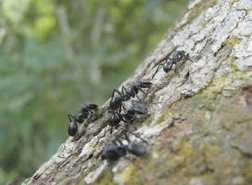Certain ants that live 30 or so meters up in tropical trees can save themselves in midair from ruinous falls by making moves previously known only in cheesy action films.

Much as a movie heroine tumbles off cliffs but routinely manages to grab something to stop her fall, the female worker ants of the species Cephalotes atratus guide their plunges so they typically veer into a tree trunk, according to Stephen P. Yanoviak of University of Texas Medical Branch in Galveston. The falling ants grip the trunk and then climb back home.
When Yanoviak and his colleagues dropped dozens of the wingless ants out of a tree at a spot about 3 m from the trunk, 85 percent of the falling ants managed to swerve into that trunk, the researchers report in the Feb. 10 Nature. If chance alone were to dictate the fall, Yanoviak says, only 8 percent would strike the trunk.
“Steve’s story is great natural history,” comments tropical entomologist John Longino of Evergreen State College in Olympia, Wash.
Ants, like many other small creatures of the forest canopy, generally survive the impact of a fall. A long fall is better than getting gobbled up by a predator, and previous research has described increased “ant rain,” a shower of ants falling from a treetop, after a bird lands.
Yanoviak argues that although a canopy ant wouldn’t die from the impact of plummeting to the forest floor, it would face perils from predators there and risk not finding its way home.
The project began, Yanoviak recalls, when he was perched high in a tree in Peru, brushing away ants that had swarmed onto him. He realized that they weren’t falling straight down.
To videotape dark ants plunging toward the forest floor, Yanoviak painted them with white nail polish. Tests of thousands of C. atratus ants, dropped from the canopy on windless days, found the majority grasping the trunk. Some returned to the treetop within 10 minutes.
Since the ants fall rapidly, some don’t manage to hold on the first time they bump into the trunk. Then, they reorient and try again lower down, says Yanoviak.
When he painted over the eyes of some of the ants, their trunk-catching rate dropped to what would be predicted by chance.
After testing several dozen species, Yanoviak reports that C. atratus is among the champs. Some species just drop. He suggests that C. atratus‘ wide head and flattened rear legs may contribute to the maneuver.
“Why not have wings?” says Longino. “I doubt there is any ant species for which the advantage of [workers’] having wings would outweigh the disadvantages, such as problems maneuvering inside nests.”





